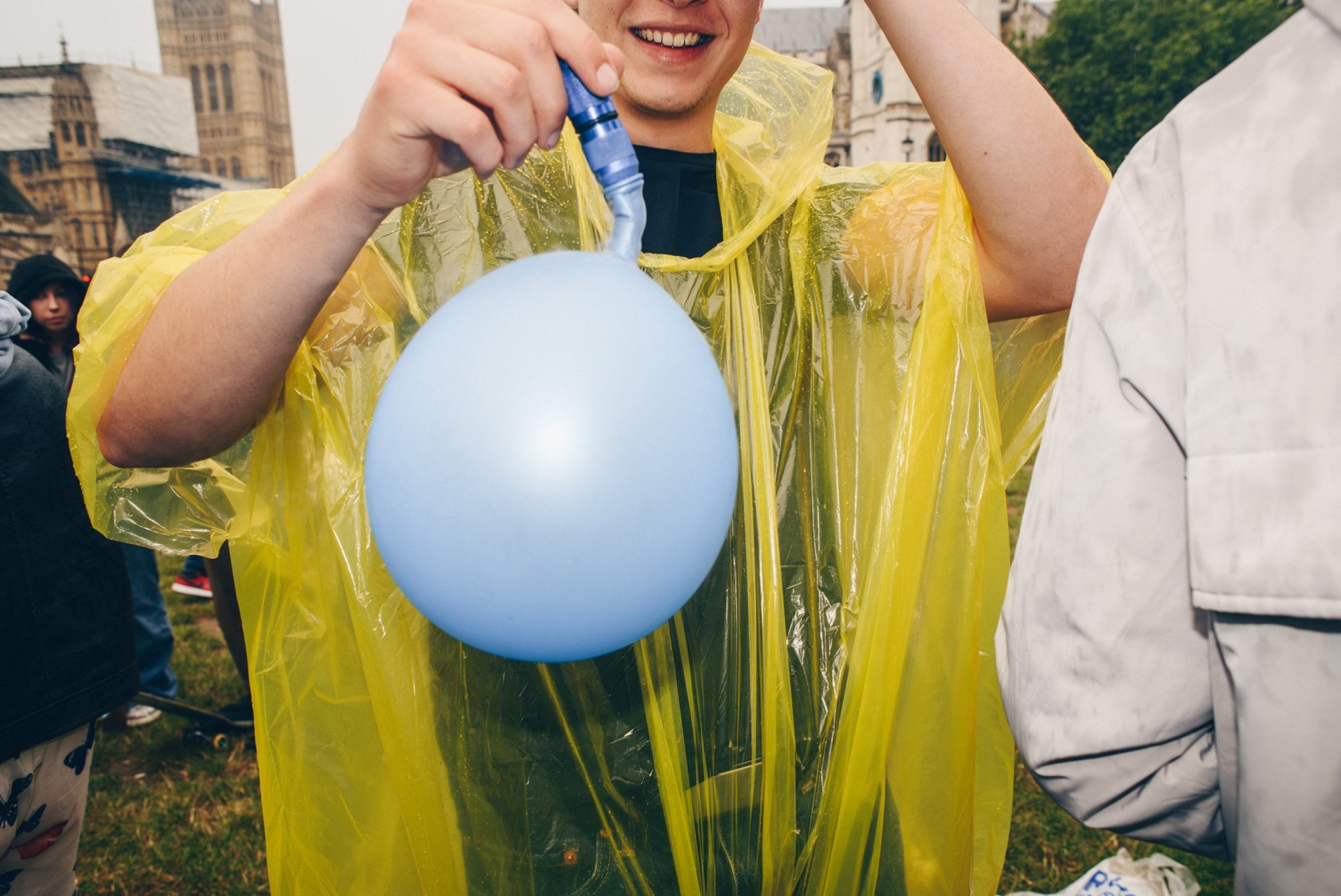 Features
Features
Hysteria, harm or something more sinister?: Why the UK is banning nitrous oxide
Tracy Kawalik investigates nitrous oxide use in the UK, talking to ‘super users’, dealers, health professionals and drug experts to unravel the hype, harm and politicking behind the ban on young people’s second favourite drug
The UK has the highest drug consumption in Europe. In London, the continent’s cocaine capital, a gram of gear, weed, Dom Perignon-shaped ecstasy, G, MDMA, crack, fentanyl, psychedelics, DMT and even rhino ket are all but a text and Prius ride away from your front door.
But the drug currently dominating headlines with reports of hospitalisations nationwide is one that has long been readily available at corner shops and online, which is now set to change with the announcement of a ban on March 27. It's nitrous oxide, occasionally dubbed ‘hippy crack’ by politicians and tabloids, the second most-used drug in the UK among 16-24-year-olds.
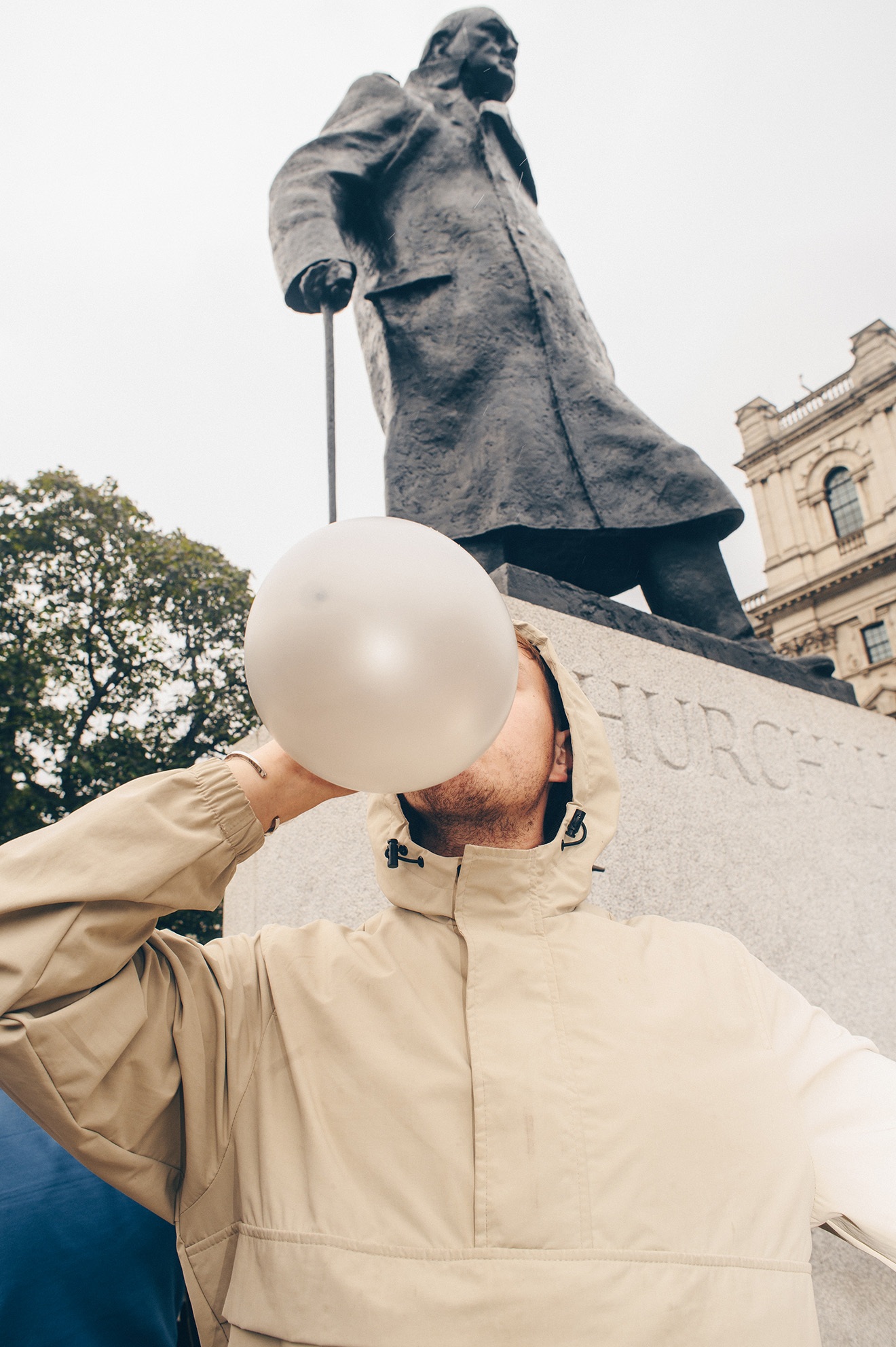
THE CONTEXT
TikTok is flooded with braggadocious boasts of folks doing a hundred balloons plus in a single sesh. But among those, Kerry-Anne Donaldson, a 26-year-old paralysed by NOS, and a handful of B12-deprived youth are sending out warnings alongside Birmingham neurologist Dr David Nicholl, who’s witnessed nitrous oxide gain traction and the devastating consequences it can cause first-hand.
“In the past, you may have seen one patient every 10 years because of nitrous oxide - it was formerly listed under medical rarities. Now NOS-induced injuries are the most common call to the Birmingham acute neurology ward ahead of other things,” Nicholl declares. “I see two new patients with nerve, spinal cord damage, and even paralysis caused by nitrous oxide every week.”
Nicholl first encountered the shift back in 2020 when he began treating an increasing number of patients experiencing tingling or loss of sensation in their feet and hands. Some were unsteady, some could barely walk, others were bedbound.
“I was cycling every day and seeing those bloody chargers, whippets and cylinders on the side of the road. It really angered me because I'm seeing patients constantly because of this stuff. I live in a very middle-class area of the Midlands, and I work in a very deprived part of the West Midlands, and you can get it from corner shops, all hours of the day, across both those areas.”
Pissed off and propelled to ignite change, Dr. Nicholl launched a personal crusade across the country to spread the word that “laughing gas is no laughing matter.” He has vocalised his growing concerns across mainstream and specialist news organisations, helping to conduct a recent investigative report with Sky News and meeting with the West Midlands Police and Crime Commissioner.
But David Hillier, a freelance drug journalist, thinks that the medical argument Nicholl is making is sensationalised scare tactics and nothing but hot air.
Read this next: From Medellín To Manchester: Inside The Rise Of Tusi, Colombia's 'pink cocaine'
Government figures report 56 people died in the UK across 2001-2020 from nitrous oxide, most commonly caused by hypoxia (insufficient oxygen in your body). It’s not a positive statistic by any means, but it is one that’s dramatically lower in comparison to staggering stats such as the 840 deaths linked to cocaine use in 2022 alone.
“To a neurologist, the number of cases and usage probably looks alarming. But to the typical Londoner who parties regularly and does balloons, the danger is not that deep. The quantities people do aren't as wild as they say, and side-effects from NOS are rare,” Hillier states.
But from Dr. Nicholl’s perspective, this is "bullshit." He points out that while a recent investigation from the ADMD found that use of the drug “reduced significantly” over the past six years, the amount of what he calls “super users” has not. He’s treated various patients with life-altering injuries, having seizures and bladder and bowel problems, mental health issues, paranoia, burnt mouths from inhaling directly from the canister and sexual dysfunction. He knows a colleague with two nitrous oxide patients who had drains inserted into their brains to save their eyesight from raised intra-cranial pressure, and one patient, now permanently blind who was not so lucky.
The London Ambulance Service recently released data which points to a trend in rising health issues related to nitrous oxide use, revealing that 999 calls for nitrous oxide incidents more than tripled in a year — with 213 recorded in 2022, up from 65 calls the previous year. The 2021 figure marked an increase of around 80% over three years from 2018’s 36 calls.
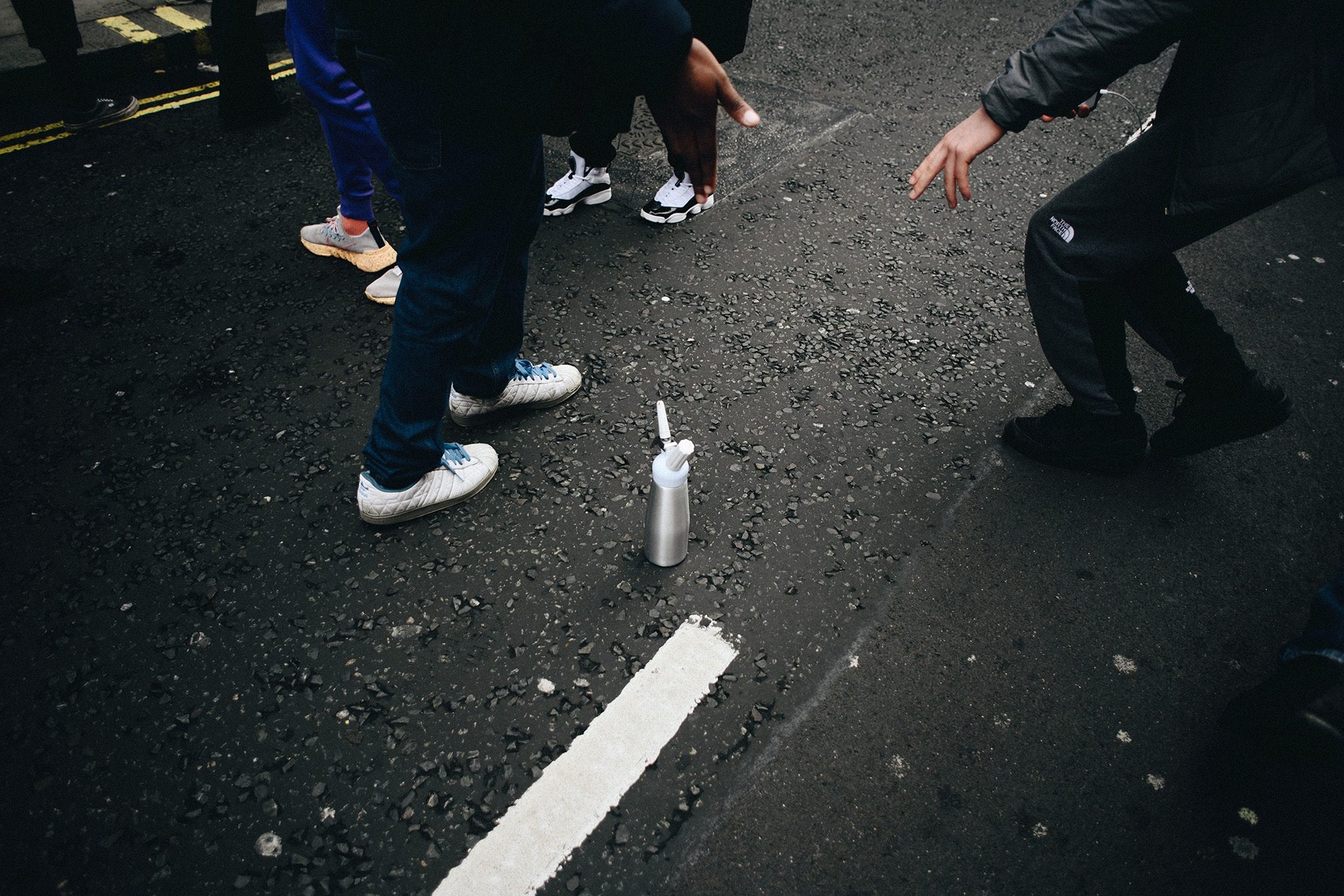
THE RESPONSE
At the top of 2023, the Home Office chimed in with big plans to push for a ban of the sale and possession of nitrous oxide as part of a wider crackdown on antisocial behaviour. Although selling and dealing NOS has long been illegal under the 2016 Psychoactive Drugs Act, huffing balloons at house parties, raves, festivals and for "catering" purposes isn't.
There are a variety of loopholes ‘distributors’ have slid through; most commonly flogging Cream Deluxe, Fast Gas and Smart Whip Chargers, (which hold 80 balloons worth of NOS), 600g canisters (152 small balloons) and up to waist-high 3.9kg canisters (over 500 small balloons) under the guise of ‘whipping cream’. "A Smart Whip from the local shop or a 2kg Fast Gas canister isn't for the Great British Bake Off!” remarks Dr. Nicholl.
In a speech, Rishi Sunak chose to swerve nerve damage and the health risks of selling NOS at dangerous quantities to instead zero in on nitrous being a “gateway to more extreme crimes”. He claimed: “They spray graffiti on war memorials, discard needles and nitrous oxide canisters in children's playgrounds, gang together and cause disorder and disruption.”
David Hillier weighs in. “Conflating nitrous oxide use with heroin use is unfortunate and it’s doubtful whether anyone could focus on graffiti while doing one balloon. Maybe Rishi should look at putting more money into youth services instead.”
Since 2010 the Tories have closed more than 800 libraries , they’ve sold off hundreds of playing fields, and crippled youth services, underfunding arts by a third and cutting local authority grants by 40%. Twitter user @MJSmigg suggests: “Try reopening the youth centres, swimming pools, lowering the price of football pitches and dance classes. Reopen all the things that austerity brought the poor but not the [privileged]. It’s simple; give the kids something to do.”
On February 7 this year, 11 experts from Manchester, Birmingham, Nottingham and the Queen Mary University of London (including Nicholl) released a clinical guideline advising doctors on how to recognise, diagnose and, most importantly, treat people suffering from nitrous oxide-induced health issues and prevent long-term neurological disability. Within the clinical guideline they revealed that there are patients using upward of 580 nitrous chargers per week, and some as young as 12.
Off the back of that, as of March 6, following a two-week intensive investigation, the ACMD (Advisory Council on the Misuse of Drugs) rejected the idea of criminalising nitrous oxide. Firstly, they felt that a ban would cause problems for those who needed the gas for legitimate purposes, i.e. the food industry, in medical and dental settings as an anaesthetic, as an acute anti-depressant, and as a component of rocket fuel and car racing. Secondly, the ACMD stressed that the Home Office should prioritise education and health warnings about recreational nitrous oxide use and focus on prevention rather than persecution. Both statements echoed previous investigations and advice they shared dating back to 2015.
But as of Monday March 27, Home Secretary Suella Braverman announced that the government has decided to ignore the ACMD. Instead it aims to ban and criminalise the possession and sale of NOS as part of Sunak’s “Anti-Social Behaviour Action Plan”, which sounds a lot more like social control and the dark days of hoodie panic.
Journalist Moya Lothian-McLean makes the case in a piece for Novara Media that Sunak’s plan essentially seeks to reframe vulnerable people who dare to exist in public view as the enemy of social norms “It’s a drug (tick) primarily used by young people (tick) often in public areas (tick) – and there’s an adjacent litter problem (GIGANTIC MIDDLE ENGLAND TICK).”
Read this next: The UK government's war-on-drugs policy is out of touch and causing harm
Calls from curtain twitchers reporting anti-social antics are inevitable. There’ll be criminal records handed out, possible jail time and community service where offenders will be made to wear high-vis jumpsuits during their punishment while carrying out tasks like cleaning up graffiti, unpaid work in shops and washing police cars.
Steve Rolles, senior policy analyst at the Transform Drug Policy Foundation says: “The idea that this is a deterrent effect is ridiculous. It just criminalises users and will hand control of the product to criminal gangs.”
Hillier agrees: “How enforceable these laws are is something that will reveal itself in time but I'm interested to see if NOS will disappear from festivals. Will balloons start turning up on more illegal dealers' menus and will production head deeper underground, creating greater risk for your everyday raver who does the odd balloon or three at an afters?” Hillier vents the thoughts of many, that Sunak’s whole ‘action-plan’ is purely an election move. “The government has brazenly ignored (again) the recommendations of the ACMD - an organisation composed of the very smartest brains in drugs science and research. They work for free and it's a grim display of politics over pragmatism,” he continues. “The decision to bring nitrous oxide under the MDA is another demonstration of the UK's blinkered and dispassionate approach to drugs policy. It suggests that they're happy to penalise young people for using a substance that has a low risk profile for the majority of users: all in the name of point-scoring with certain, let's kindly call them squarer, elements of the electorate.”
Even Dr. Nicholl, who’s been campaigning for a crackdown, has misgivings about the government’s actions. “May the 4th, local elections, this is what this is about,” he says. “Everyone was saying ‘congratulations’ to me, ‘well done on your campaign, you should be happy’ when actually, I don’t think they’ve done the right thing. Why are we not using the existing legislation? I think the government should be focusing on education, a public health approach and cracking down on the supply chain! I gave a list of names to the police last September of ‘legal’ suppliers who were selling unsafe quantities and not one of them has been arrested. More investigative journalists have visited those suppliers than police.”
“The devil will absolutely be in the detail. There’s a bunch of issues,” he adds. “You can’t ban NOS because it’s used in too many different things from drag racing to coffee. Then, if they are to ban it, where would the cops even recycle it all because the stuff is explosive. There have been fires in recycling centres already.”
The Transform Drug Policy Foundation already mooted a solution to put a deposit scheme into action where users return their canisters or whippets to a machine for a small fee. “Instead of criminalising NOS they should ban the bigger tanks which promote much heavier use and work out a way to stop people littering their empty canisters,” agrees Hillier. “The litter and environmental issue is critical and legitimately unacceptable in my opinion. Canisters are made from steel so can, in principle, be recycled. But many UK councils do not accept them. The only place you can ensure they don’t end up in landfill is by taking them to a metal scrap yard. So there's a little side hustle waiting on the street if someone wanted to collect them.”
Recreational use of nitrous oxide dates back 200 years, but in Nicholl’s experience over the last three years the quantity of doses has gotten dangerously out of hand. He gives the analogy: “If I walked into the chemist and asked for 100 paracetamol, they wouldn't supply me with that dosage. Because of that, there has been a significant difference in the risk of overdoses. Nitrous oxide suppliers are selling canisters that are waist high, by the pallet, and at corner shops, online and to your door to all ages, all quantities, all hours of the day.”
Texts flew around following March 27’s announcement about the impending criminalisation for final blow out balloon parties before the ban kicks in around Bristol with partygoers bringing 600 canisters each. While the organisers were denied their typical purchase for the first time, they were still allowed to purchase two lots of 350.
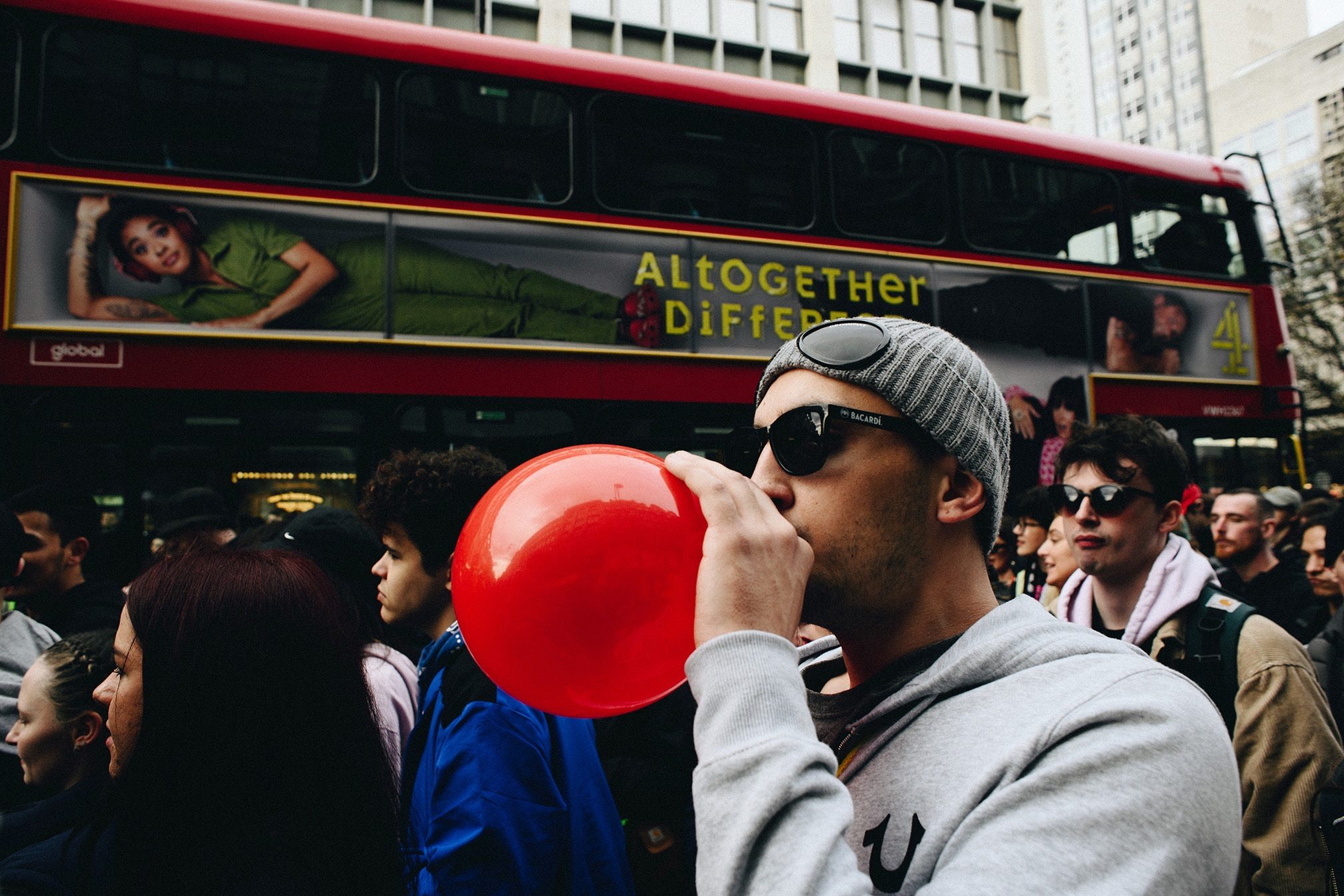
THE HISTORY
So how did we get to this point? “Laughing gas / nitrous has been an integral part of the architecture of the afters for a long time,” David Hiller notes. Balloons at a function are no new thing. English scientist Joseph Priestley discovered nitrous oxide in 1772. But by the turn of the 19th century, another British scientist, Humphrey Davy, unearthed their psychoactive properties, coined them ‘medical airs’ and started puffing and passing to all his mates in a silken bag. Davy got so hooked he built an ‘air-tight breathing box’ that he could fit inside, releasing nitrous intermittently. One friend and poet Robert Southey even went as far as writing: “I am sure the air in heaven must be this wonder working gas of delight.”
The upper echelons followed suit and threw ether and laughing gas parties. Charlie Chaplin starred in a silent film in 1914 called Laughing Gas while travelling, opportunists took ‘medical airs’ to carnivals where people could laugh and act silly for a small fee while they breathed the intoxicating fumes.
Amid the hedonistic heyday, American dentist Horace Wells saw a man at a party inhale NOS seconds before he bailed over a bench, cut open his leg, and didn't feel a thing. Awestruck, Horace convinced his partner to remove one of his teeth the next day while he was inhaling nitrous oxide, and it worked… general anaesthesia was born.
Read this next: Ecstasy island: How MDMA reached the UK in 1988
In 1978 the first cases of nitrous oxide nerve damage were reported when 14 dentists who abused laughing gas heavily suffered temporary paralysis and made the connection to depletion of B12. They lost their jobs, but the health risks they experienced from laughing gas were skipped over as ‘over-inflated’ facts.
Nitrous for recreational purposes continued to drift into the bohemian scene among beat poets. By the noughties in Britain, the balloon business at raves, squat parties, and festivals was booming.
In 2010 Prince Harry was caught inhaling them with a crew of long-legged aristocratic pals at Mayfair nightclubs every weekend in the Daily Mail, reportedly loving the two-minute euphoria at £1.50 a pop. The Mail commented “laughing gas is the latest, perfectly legal — recreational drug of choice for the middle classes.”
Waves of top footballers got in on the action, with nitrous being the ideal extracurricular they couldn't be drug tested for. Grime producer Swifta Beater and boxer/DJ Tom Zanetti even released their own ode ‘Balloon Tune’.
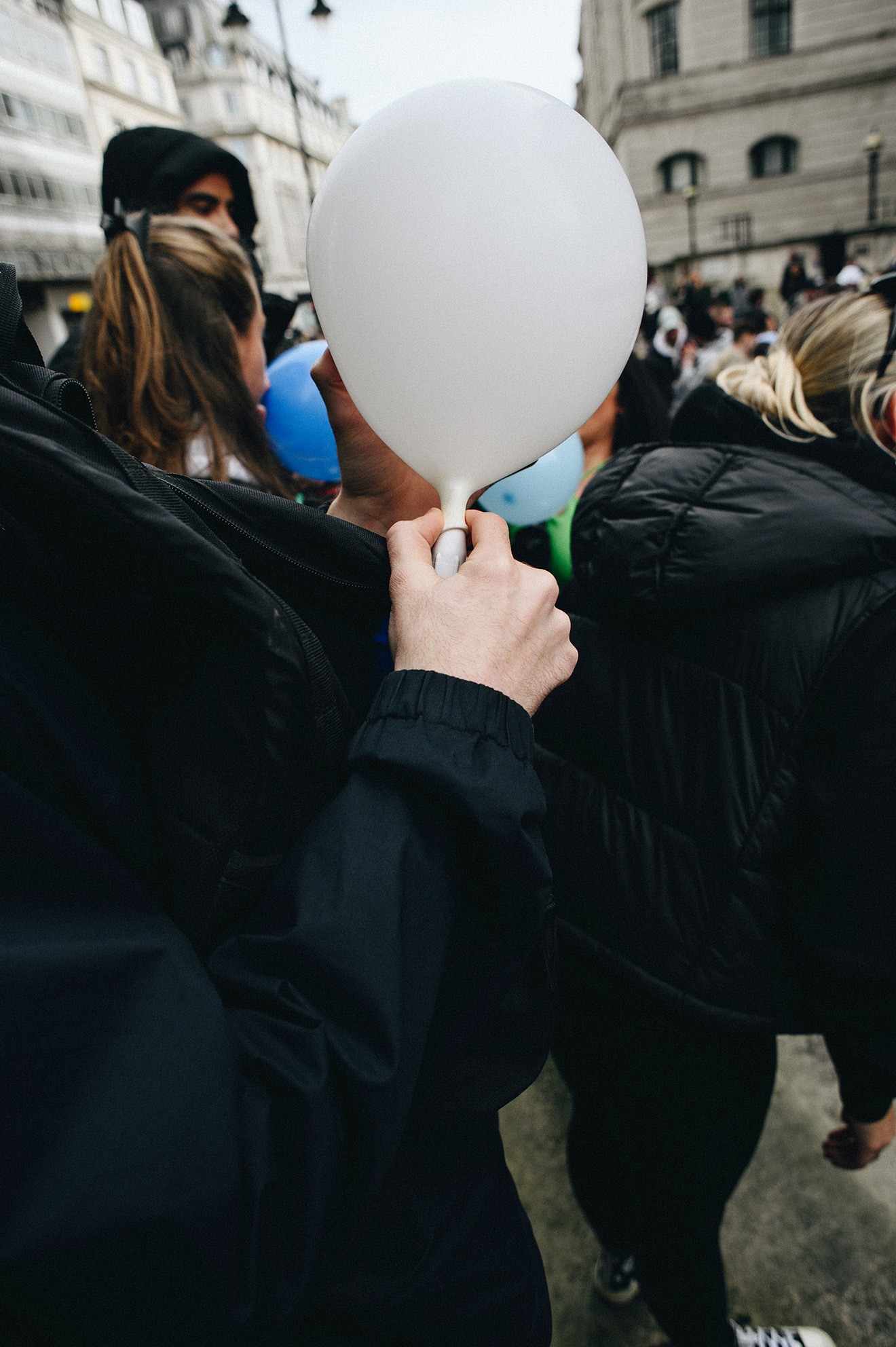
THE DEALERS
But after a handful of deaths took place associated with it, a media frenzy followed as illustrated in the 2016 VICE article “The year the tabloids won the war on drugs” . That prompted the government to add nitrous oxide to the 2016 Psychoactive Substances Act (a law that came about in response to the popularity of legal highs, banning the sale of anything that can change your mental state apart from cigarettes, coffee and alcohol — poppers escaped the ban last minute.)
Overnight, dealing nitrous went from being legal to a sentence of up to seven years behind bars... if you were caught. There was an increase in the theft of medical NOS canisters from hospitals to keep pace with nitrous-fuelled raves and squat parties, where alcohol was no longer the main attraction. However, inhaling NOS remained legal.
In 2023, with one quick swipe on the internet you can find a host of sites delivering ‘premium’ NOS chargers/canisters of all sizes - in fact, for £8,150.00, you can order a palette. There are ‘how to’ guides, opportunities to become a distributor yourself, and glowing customer reviews; some sites offer a discount if you pay in bitcoin. You have canisters emblazoned with cheeky SnapChat QR codes, and bootleg Grand Theft Auto graphics called ‘Miami Magic’. As well as liquid drops developed in the Netherlands which have recently launched in strawberry, banana, mango, peach, blueberry to add flavour to your NOS, and one brand that hit the market last month in France claiming to be halal. Meanwhile, local shops are packaging their nitrous canisters (selling all quantities to all ages) with balloons, crackers, and even vitamin B12 supplements.
As business has become more lucrative there has also been increasing tension between street dealers and NOS gangs, rumours of NOS gang stabbings being suppressed by festivals and a non-gang related murder of 23-year-old Max Maguire in Lymington, Hampshire, over a dispute about a NOS cannister.
In the 2017 VICE documentary Inside the Laughing Gas Market one street dealer risking it nightly outside clubs by loudly inflating fluorescent balloons to queues of punters in full view of roving police commented: “I don't like to sell balloons on road you know, because that's when you get mixed up into the wrong crowd and people see you as a drug dealer. Really and truly, before the law changed, I was doing this with an entrepreneurial spirit. The reason I chose to sell balloons was that I figured, alright, I could just go out, sell something that's not illegal and make money from it, elevate my situation. Suddenly I feel like a criminal and that I'm doing something that yesterday was looked at as smart business.”
When asked how popular laughing gas was after the PSA ban, the dealer replied: “On a scale of 1-10, I'd say 100. When I crack one open, and the sound goes off, people flock to me like birds.”
Read this next: Bust to boom: How drugs won the war on drugs
A South London rave collective, who wish to remain anonymous, chip in on the debate. “I'm 33 now, and I was kinda there when it all started to pop off with selling balloons. Loads of my friends got heavily involved in it, from starting businesses selling crates of cream chargers to mates who would roll to a festival with a rucksack full,” one DJ says.
"On average, I had mates that made £2000-£5000 at festivals, depending on how hard they was looking to graft. It's hard to get it into festivals 'cause you can't put it up your bum,” he laughs. “So you either have to know someone at the gates or have a sneaky tactic like dressing up as paramedics with big holdalls.”
“The two guys I know ended up minted from it. I remember they drove to a festival in Croatia with a van full of balloons, whippets, crackers etc. and came back with £50k! Last time I spoke to them, they'd made £250k.”
As the hype for nitrous caught further momentum, dealers were pushed to innovate and meet demands. Users were hit with ‘inflation’. Gone were the days of balloons for £1.50. Outside London day festivals last summer, dealers were hustling balloons for £15 a go, passing around flash business cards and accepting PayPal. Outside the MOTH Club in Hackney, a girl with an iZettle must have sold 30 minimum in under 10 minutes at £10 to a growing queue waiting for Ubers.
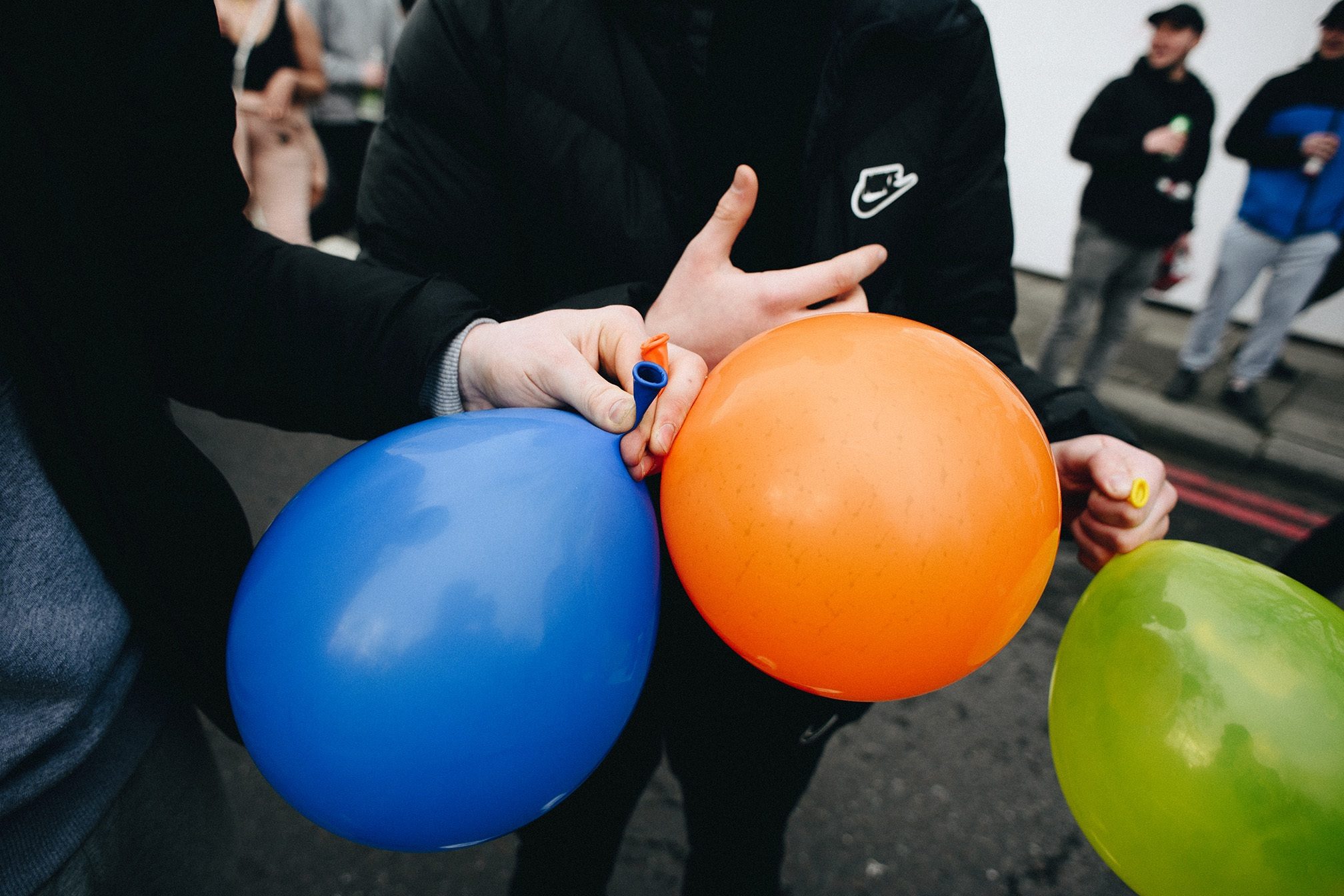
THE USERS
Balloons are a staple at festivals and afters. Inhaling one or two balloons are unlikely to do any lasting damage other than give you a psychoactive one or two minute trip laced with euphoria and laughter. “I do love sitting around the camp at a festival off your noodle on a concoction of drugs, then hugging a balloon takes you to the next level of fun,” says one of the aforementioned anonymous DJs.
“I would never take it again,” another member of the collective adds. “Cannot handle it now, but so many memories from being young and a lot of those were really, really fun.”
“Personally speaking, as soon as you do one, you want another!” she continues. “It's definitely addictive. It's like ‘crack’, hence the nickname I guess, where people just can't/don't wanna stop ‘feeling the feeling’. When I was 14-years-old and started going to illegal raves and squat parties, I knew boys two years younger than me who were fully addicted. They were cracking them constantly. They didn't do any other drugs. I had one mate who would do them 24/7. While he's huffing one, he would be charging up the next. He ended up fucking his back up and spinal cord because it took away the B12.” She pauses. "I remember at raves some people would fill up a space hopper (like huge!) full of NOS and just have it up to their mouth the whole time... a constant supply of NOS to their brain.”
Hillier adds: “You’re statistically more likely to get hit by lightning than die from laughing gas and a few balloons at an afters is unlikely to do much damage presuming you’re not doing it standing on the side of a bath and you’ve not got underlying health issues. But people do need to understand that caning SmartWhips on a regular basis can be very bad news.”
The ACMD reported that there has been an increase in usage levels among communities that don't usually engage with substances for religious or cultural reasons, especially among young people.
The bottom line is this: heavy use of nitrous oxide will inactivate B12 in your body. B12 is crucial in producing myelin, the fatty sheath around nerves in your body. When B12 is inactivated, myelin can't function. Hence, nerve and spinal cord damage, which can be irreversible if untreated, and a slew of other life-altering neurological injuries.
Dr. Nicholl comments that while using balloons seems normalised, misusing them carries an usually negative stigma. Having campaigned on a broad range of topics as a human rights activist he explains: “I've never known anything like it. I've never met patients suffering from addictions who will tell me instantly who their dealer is but won't discuss publicly that they are using. The trouble with statistics is that some patients will come in and say they're doing nitrous and then retract that a week later. Or simply stop coming back.”
Read this next: Do you have to do drugs to enjoy dance music?
In five months of research, all the people who reached out as ‘super users’ and agreed to share their stories cut contact last minute. Until during the final edit, a late-night TikTok DM came in from Kerry-Anne Donaldson, and an anonymous text from *Portia, who'd been floored by Dr. Nicholl's Sky News report and felt she had a responsibility to bravely and positively impact others in her situation before it's too late.
“I was one of those people who was dead against drugs, I had siblings who struggled with addiction, so I was always the person on a night out who stuck to cocktails and said no to Class As,” Portia says. “I'm super organised, I've held down a job I love for 16 years in the medical field, I volunteer a lot, and I'm a mum.” But a year ago, she hit a bad patch. After discovering a painful family secret, Portia began drinking heavily to cope and eventually tried a balloon with friends to numb the pain. "It wasn't that I got addicted to it. It's that it provided a bit of release from the situation I was going through. Also, it was so easily accessible. Every time I purchased it, it was from the local convenience store.” Nitrous became a standard component of every fortnight, escalated to every weekend, and even to her pushing her partner to get NOS on dinners out.
“When it started becoming a problem, my partner was saying, 'Are you not reading what's online? People are ending up in wheelchairs because of this shit!' I'd fight back and say they probably did them every day. I was thinking this would never happen to me." Portia admits that, on average, she was doing the equivalent of 24-48 balloons every week.
"After a couple of months, my taste started going. I love hot food, but it got to the point where even the blandest of things were so spicy I was doubling over. I got a sore tongue, put it down to COVID, but that was the start of my B12 going." Portia continued using nitrous. Her skin went pale, she was bloated, had a fever, and her mental state became very clouded. By the following Friday, she couldn't walk. "I got out of bed and dropped straight to the floor." Portia went to the hospital, where she was given tests as well as shamed by a consultant about recreational drinking. Too embarrassed to mention her NOS habit, she left. Luckily another neurologist got wind of her results and had Portia rushed back to the hospital, skip A&E and immediately see a team of junior doctors. "There were all these people in the room, standing around me, and that's when I knew this was very serious. I could see they were doing everything to determine what was wrong, so I had to come clean." Portia told the lead doctor, who was supportive, sent her for an MRI, and put her on B12 injections. In the end, she was in the hospital for two-and-a-half weeks, lost the ability to drive and went through a year of intensive rehabilitation until she regained feeling and mobility.
Aspiring tattooist and piercer Kerry-Anne Donaldson went viral on TikTok when she posted a horrifying ‘before and after’ video of herself going from nights out doing balloons to being hooked up to machines and hospitalised, paralysed with a damaged spinal cord and forced to rely on her dad for round-the-clock care.
“I started doing NOS when I was 18 but I would just do it occasionally at parties. There wasn’t the big canisters about then, it was only the individual ones and there was no one educating people or talking about the risks. So at that point, I was maybe doing 48 canisters every two months or something. By the time I got to about 20 I was doing 400+ canisters a month,” Kerry-Anne says.
“I liked the buzz it gave me at the start, then it became about trying to chase that. Also, I was going through something and doing them stopped my mind from overthinking.” Kerry-Anne takes a breath. “At 21, I woke up one morning and my legs, my hands, my arms had gone completely numb. I couldn’t stand up , I couldn’t pick up things. My older sister took me to the hospital.”
Kerry-Anne was honest about her usage and the doctor informed her she was experiencing a nitrous oxide overdose, B12 deficiency and nerve damage. “I stayed in the hospital for a few weeks. I came out and a district nurse had to come to the house daily to give me B12 injections. I was bedbound.”
Kerry-Anne got better, started walking, but was still suffering with depression. Between 22 to 23-years-old she started taking nitrous again at staggering levels. “I just wanted to take them to forget life. This time I was abusing it to the point where I was having 600 canisters in a week. I’d do it hidden away from everyone. I’d do it at home alone, I wouldn’t pick up my phone. I’d do it from waking up to when I fell asleep each day.”
“The following week I’d be vomiting, I couldn’t eat, unable to drink water. I was going through withdrawals; sweating, shaking. I would just stay in bed, constantly trying to sleep it off. By the weekend I’d feel better and then do it all again,” Kerry-Anne admits.
At 23-years-old she started to feel her left leg going, she was walking around on a crutch hoping she would bounce back like the previous time. “Throughout the whole period from when I 18-23 was an ultimate low. I was destroyed, yet here I was taking something that was destroying me even more. I didn’t want to go through what I’d went through in the hospital again so I stopped doing NOS.”
Read this next: Why DJs and ravers are embracing sobriety
But by Christmas time at age 24 she was getting B12 injections again. She’d gone from one high to another and started drinking. By the end of January, she woke up with excruciating pain in her stomach and no feeling in both her legs. She had pancreatitis from the drinking, anaemia, no B12 and a slipped disc in her lower back from nitrous.
“I came out of the hospital in March. My dad had to completely care for me. If I needed to go to the toilet, I had to use a commode and he’d have to clear it out. If I needed a bath, he’d have to put me in a lift they’d sent home with other equipment. That was the biggest obstacle to get past was having to constantly ask family and the people around me for help. I was bedbound until June before I could even be in a wheelchair.”
Kerry-Anne refused to give in and let the depression be victorious. “When I started helping people and I realised I could turn my negative into a positive; that was so uplifting for me. I posted the TikTok and it started blowing up.”
She started doing TV appearances, telling her story to magazines and newspapers. She focused on improving her artwork portfolio, drawing and her passions to open her own shop as a tattooist and change lives worldwide by spreading awareness.
“I put my Snapchat and Instagram on TikTok so people could message me and I started getting loads of messages from people in Dubai, France, America. I had loads of messages where people have opened up to me about their personal and family life that’s causing them to do balloons. They’ve been too embarrassed to tell doctors or anyone about doing NOS and the symptoms that they might be experiencing or ask for advice. So it’s very touching that they feel they can, and I’ll have no judgement. Even people’s mums have contacted me to help their children. “
Kerry-Anne and Portia aren’t the the only one’s passionate about spreading awareness. There is a long list of groups such as N20: Know the Risks, a campaign and youth outreach group set up by Queen Mary University while Dawat-E-Islami Midlands is also distributing health leaflets to offer support and education.
“It’s incumbent on us in public health to educate people about this in a big, big way.” says Nicholl. “The users don’t need to be targeted, they need to be educated. Having spoken to the Dutch Ministry of Justice and Ministry of Health it’s really clear they are approaching NOS as a public health issue rather than a criminal matter. The so-called Dutch 'ban', said to start from January 1, will in fact not start until July at the earliest, with a focus on education rather than incarceration.”
In a statement sent to Mixmag, Tim Bennebrook, the press officer for the Dutch Ministry of Health, reveals: “The ban on nitrous oxide is hopefully going to help with [minimising health damage]. But of course, prevention is also part of the solution to reduce nitrous oxide use. For example, we have several Dutch websites that provide information about nitrous oxide and the risks. There are also educational materials made specifically for parents, teachers and municipalities. We see over the last year that nitrous oxide use now also seems to be decreasing. However, incidents involving nitrous oxide are increasing. Therefore, it was necessary for the Netherlands to also adopt a nitrous oxide ban in addition to the prevention measures in order to decrease the wide availability in nitrous oxide."
NOS-induced neurological issues weren’t the only problem in The Netherlands. The Dutch government's crackdown was also responding to a startling list of NOS-impaired vehicle accidents — with 63 fatal accidents and 362 accidents that left the drivers or passengers injured recorded in the past three years. In total NOS was a contributing factor in nearly 1,800 accidents.
Last month in Bradford, the West Yorkshire Fire and Rescue Service spread awareness about the increase in nitrous related car accidents in the UK by staging a mock accident in the city’s Centenary Square to demonstrate what laughing gas can do behind the wheel.
“One of the first times I did a balloon was in the backseat of a car travelling from Kent to London,” shares an anonymous DJ. “Both the drivers were doing them the whole way. I didn’t realise until we got out of the car, that the guy in the passenger seat was also paralysed!”
“I know someone in East London who lives on the 7th floor of a block. She was at home watching telly the other day and there was a huge thud. She said it felt like the building was exploding, but actually it was a boy driving 70mph right through someone's front room below,” she adds. “He climbed out of the car and started immediately stashing Smart Whip canisters because he’d been doing them when he crashed!”
Read this next: Universities should help students "take drugs safely", say researchers
Portia believes preventing accessibility is important. "I had to have physio come to my house three times a day and I took up a hospital bed for two weeks and I'm still using [NHS] resources a year later," she adds. "Now, I’d never touch it again because I know what I’ve gone through. I’d love to turn around and say to people ‘Don’t touch it’ but people don’t listen to that. I didn’t listen to that. What I would say is to make sure you look out for the symptoms and as soon as these symptoms start, get help straight away. Don’t be chasing these highs that are going to ruin your life."
Kerry-Anne now has permanent health problems, and is staying positive by focusing on the the educational value she can bring. “I’ve made progress where I can stand up and get out of bed, I can get around my house but I’m still unable to walk properly. When I go out I am still in a wheelchair. I’m always going to have this pain, when I spoke to doctors they’ve said that won’t go away now. I take 11 different pills a day and I’m always going to have to be on the medicine I’m on,” she says. “I have goals I want to achieve. The thing that keeps me motivated is my family and knowing that I’ve helped someone. When people reach out who have heard my story or seen my stuff and said ‘because of you I stopped doing balloons’ or that I pushed them to go to the doctors and get their symptoms checked out early on, that’s my proudest accomplishment. I’m 26 now and I don’t want any of the younger generation to go through what I’m going through.”
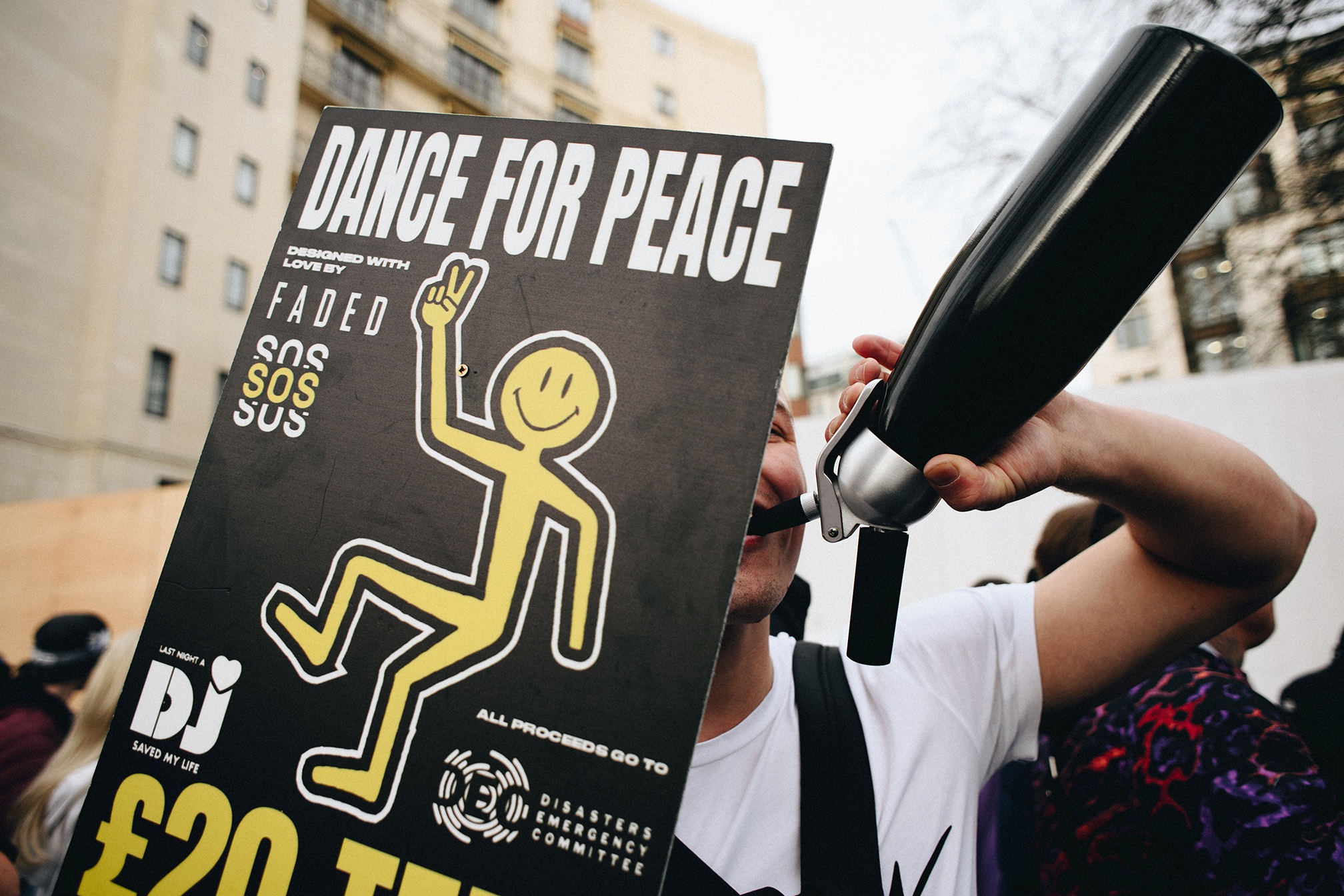
The conclusion
It's evident that NOS taken in extreme quantities is a serious issue that needs to be stopped. While the majority of people don’t experience health problems, there is a minority of heavy users that do, which is rising. Education is key: laughing gas is the second most-used recreational drug amongst young people and signs indicate they’re not going to suddenly just stop because of a ban. Since the announcement, there have been warnings broadcast over the PA at London's Canada Water about the criminal offences users and dealers will face, yet outside nearby venues and DIY parties there are still swathes of post-rave punters purchasing and safely enjoying balloons. The reasoning behind the Tories' ban - against the advice of experts - is suspect, and likely designed to get headlines and votes, while creating more socio-economic problems and pushing the sale of nitrous into the hands of illegality.
The most critical factor is prevention not persecution, cracking down on ‘legal’ suppliers pushing excessive levels to all ages to insure that the NOS usage doesn’t escalate from a one minute blast of laughter at the afters to people being slapped with criminal records or tampering in excess that could impact the rest of their lives.
Tracy Kawalik is a freelance journalist, follow her on Twitter
*Name has been changed to protect anonymity


